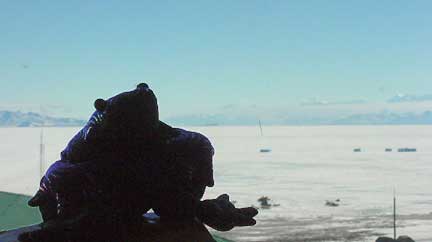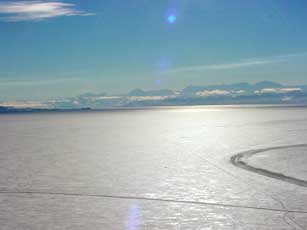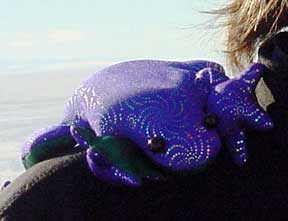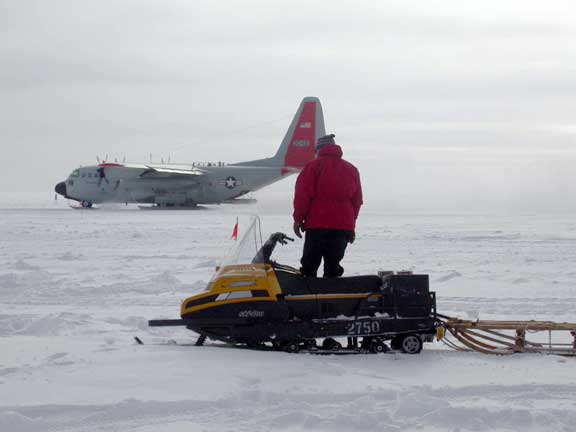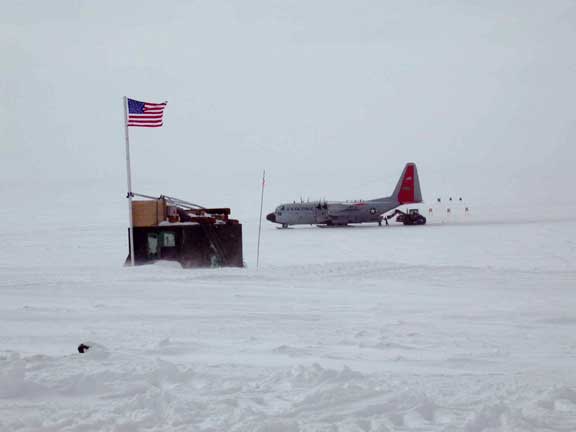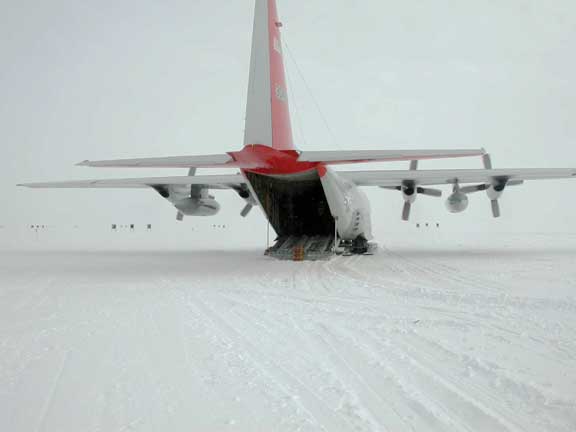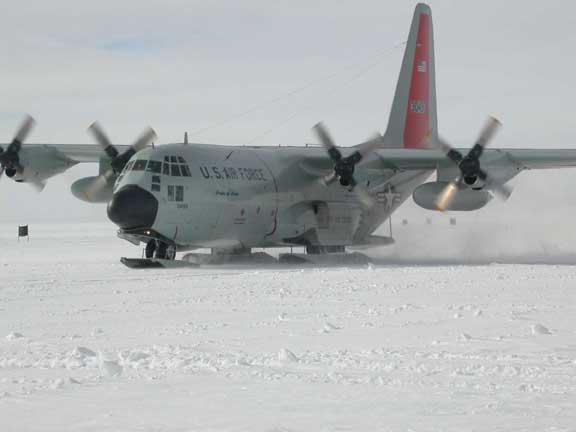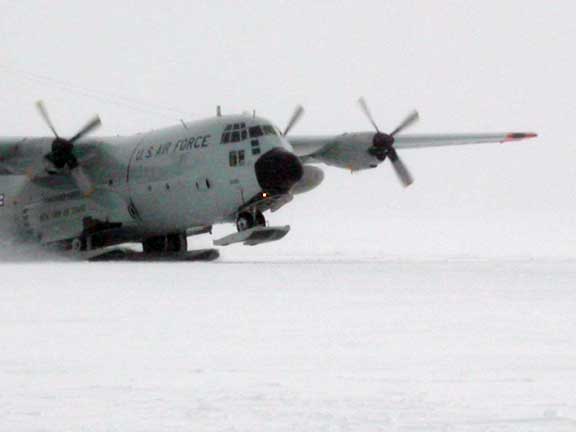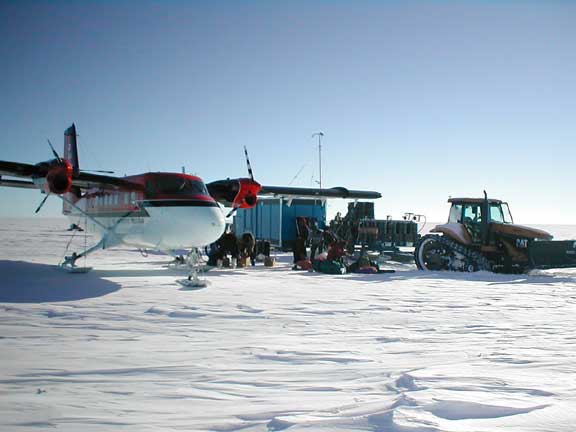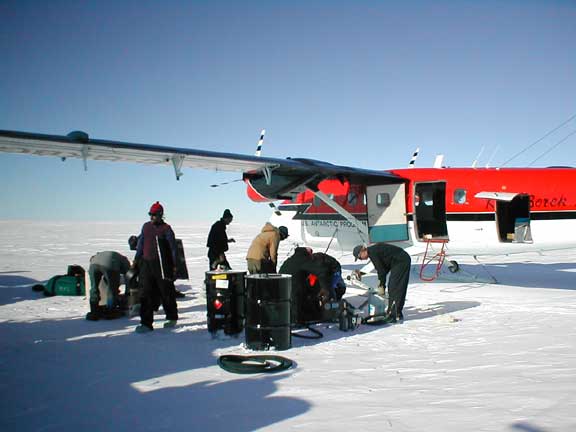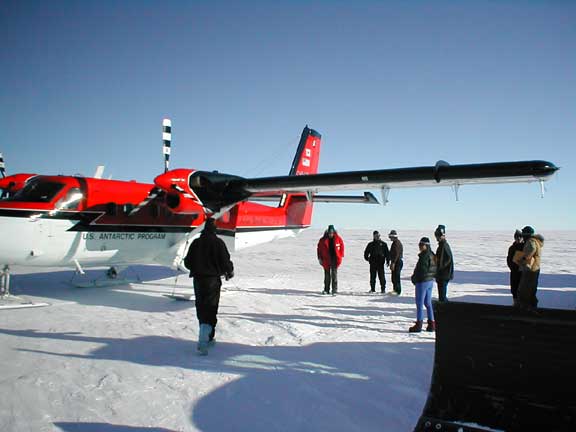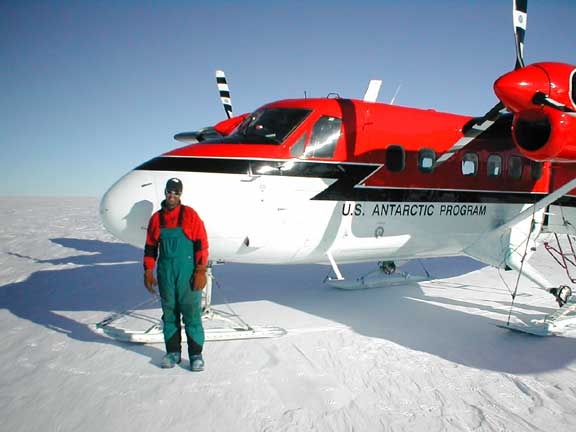
- 1999
- 2000
- 2001
- 2002
- 2003
- 2006
- 2007
Week 6 - December 2, 2002 to December 8, 2002
Date: 12/08/02
Latitude: 81 degrees, 4 minutes, 36 seconds South
Longitude: 115 degrees, 4 minutes, 49 seconds West
Temperature: −15°C( 5°F)
Wind speed: 4 knots
Wind Chill: −20°C( −4°F)
Wind direction: Southwest
Meters of ice collected: 71
Notes on daily life:
By Dan Dixon
Since leaving Byrd Camp we have been driving nonstop for over 32 hours. At present we are slightly over halfway to our first official destination,
Site 1. We experienced a bit of difficulty at way point number 4 (about 40 km away from Byrd), the snow was very deep and very soft. It had a 1 cm–thick
hard layer on the top and underneath that was about two feet of sugary snow (sugary snow resembles fine granulated sugar). The sugary snow has very
little cohesive strength (it flows through your fingers like sand and it is impossible to make a snowball out of it); this makes it difficult for
the Caterpillar tracks to get a grip. Thankfully, the new wide tracks and Aalaner fuel sled handled it well and we were only delayed by a couple
of hours in this soft snow area. After way point 6 (about 60 km away from Byrd), the surface conditions improved and made progress easier. Way points
are predetermined points spaced approximately 10 km apart between sites, we stop at every way point to check the Cats and the trains.
Driving over an ice sheet is no easy task; it requires several people at any one time. Two people are required to drive the Challenger tractors, one for the crevasse radar, one for the shallow radar and GPS, and one more for the deep radar. This makes a total of five people required to be awake and working.
We usually work six–hour shifts to allow some time for sleep, but even sleeping is no pushover. While the trains are moving, the sleds rock back and forth and up and down (like a boat in a rough sea), there are also occasional bumps as the sled skis drop over the edge of sastrugi (sastrugi are like sand dunes but made of snow). It is not uncommon to be thrown completely out of your bunk while traversing areas with large sastrugi. All this makes driving over ice sheets quite an ordeal. We all look forward to reaching Site 1.
Date: 12/07/02
Latitude: 80 degrees, 8 minutes, 58.06 seconds South
Longitude: 119 degrees, 0 minutes, 18.81 seconds West
Temperature: −20°C( −4°F)
Wind speed: calm
Wind Chill: −20°C( −4°F)
Wind direction: North
Meters of ice collected: 71
Notes on daily life:
By Dan Dixon
Finally, we are underway once again. The new wide tracks and Aalaner fuel sled seem to be doing the trick. We left Byrd Surface Camp about four hours
ago and we haven’t been bogged down once. We are managing to maintain a blinding speed of 9 km/h!
The snow surface seems to be slightly firmer than it was over a week ago, this is probably due to hardening from the wind and melting from the sun. It feels really good to be moving on and gaining ground again, everyone seems a lot happier now that we are progressing. Gordon, Mark, Andrea, Blue, and I spent the first 10 km of the trip on the roof of the blue room. We witnessed some fantastic phenomena from our bumpy perch. The first unusual thing we saw was series of mirages that look like icy cliffs in the distance. Next we saw huge patches of fog stretching all along the horizon, the fog shimmers in the sunlight and looks like icy water. At one point, the leading train completely disappeared from view as it drove into the fog. As our train entered the fog, it became clear that the ‘fog’ was actually extremely fine ‘diamond dust’ (ice crystals). The air all around us was shimmering and sparkling as if it was raining glitter. As we drove further into the fog bank, beautiful fogbows (similar to rainbows) appeared with all the colors that one could imagine. After a few hours of roof riding, we all began to feel a bit chilly so we retreated back inside to the warmth of our shelters.
While we were busy admiring the ice–sheet phenomena, Brian was busy conducting deep radar surveys, Jim was inside the blue room operating the shallow radar, Karl was driving the first train, Lynn was driving the second train, and the surface snow sampling crew collected samples from every other way–point. The science never stops around here.
Date: 12/06/02
Latitude: 80 degrees South
Longitude: 120 degrees West
Temperature: −16°C( 3°F)
Wind speed: 6 knots
Wind Chill: −23°C( −9°F)
Wind direction: Northeast
Meters of ice collected: 71
Notes on daily life:
By Jim Laatsch
Today we started getting everything shipshape for our second try at the pole. Despite the odd feeling of dÈjý vu everyone pitched in to get ready to
depart Byrd. Lynn and Carl once again amazed us with their ability to perform mechanical works of wonder. They were able to change the tracks on the
formerly narrow–tracked challenger to wider tracks that will allow us to pull better in the deep snow. This was no small feat and involved jacking
the tractor up and using the forklift on the other Challenger to help remove the old tracks and replace them with new ones. Each of these tracks weighs
nearly a ton and this is a difficult task even in a properly equipped garage. Carl and Lynn (with the notable assistance of Dan and Brian) were able
to accomplish this in the middle of Antarctica exposed to the elements and with out anything but the most basic of tools. Remarkable! Perhaps the most
impressive part of the whole thing was that they finished in only a few hours when we had been expecting this job to take about two days. Thanks chiefly
to the skill of these two we should be ready to depart Byrd Surface Camp tomorrow afternoon. Betsy and Markus have been burning the midnight oil, well
actually the sun is still up at midnight, but nonetheless they are working late finishing off the chemistry measurements for Byrd so that they too
will be ready to depart tomorrow. The rest of the team spent the time getting the science equipment ready for the trip and pitching in around camp,
so tomorrow we'll be ready to roll.
Date: 12/05/02
Latitude: 77 degrees, 51 minutes South
Longitude: 166 degrees 40 minutes East
Temperature: −2°C( 28°F)
Wind speed: 12 knots
Wind Chill: −13°C( 9°F)
Wind direction: Northeast
Meters of ice collected: 20
Notes on daily life:
By Leigh Stearns
I arrived in McMurdo last night from New Zealand after several hours of sitting around waiting for the weather to clear. There were only 15 passengers
and a lot of science gear, which made for a fabulous flight. When the plane is filled with passengers there is absolutely no room to spread your
legs and an 8–hour flight can get a bit torturous.
My task while I’m down here is to resurvey nine sites, ~100km apart, in West Antarctica. Below is an outline of what I have to do at each site and why.
- Horizontal Velocity: At each site I will resurvey poles using GPS (Global Positioning System). By comparing the current position of the pole to the position that we recorded when we installed it, we can determine how fast, and in what direction, the ice is moving at that site.
- Vertical Velocity: The infamous (to us) ‘coffee can method’ allows us to determine the rate that ice moves down (vertically) over time. The mass balance of an ice sheet depends on the rate of vertical velocity compared to snow accumulation. If more snow is accumulating on the surface than is traveling downwards, the ice sheet will thicken. The vertical velocity, however, is hard to measure and our coffee can method is described in more detail at. Essentially, a metal marker or ‘slug’ is buried about 10 meters deep. After a few years, we go back to this site and measure how far down it has traveled – this gives us the vertical velocity (for those inquisitive minds: these metal markers used to be actual coffee cans, hence the name, but now we use metal ‘slugs’ ~5” long).
- Automatic Weather Stations: At a few sites that I’ll revisit are Automatic Weather Stations that are collecting data on wind speed and direction, temperature and precipitation. These measurements give us continuous information about snow surface elevation changes (snowfall) and firn compaction, and are an important compliment to the coffee–can sites. I will be making sure these stations are actively collecting data and, if they are no longer working, I’ll dismantle them and return them to McMurdo.
Date: 12/05/02
Latitude: 80 degrees South
Longitude: 120 degrees West
Temperature: −14°C( 7°F)
Wind speed: 10 knots
Wind Chill: −23°C( −9°F)
Wind direction: North northeast
Meters of ice collected: 71
Notes on daily life:
By Dan Dixon
Today was another beautiful day, although the wind did pick up and the temperature dropped slightly. Most of the science conducted over the past few
days was complete so people sat around in the Jamesway chatting and working on our computers. We were all a bit apprehensive while waiting for our
cargo flight to leave McMurdo. Lynn was kept busy with the weather observations; the 109th Air National Guard require that weather observations be
given six hours prior to off–deck (takeoff) and each hour after that until the plane touches down at its destination. The flight from McMurdo to
Byrd Camp takes three hours, so Lynn provided a total of nine weather observations throughout the day. The HF radio we use to contact McMurdo is
situated in the Jamesway, this means that we can monitor events as they happen while we work. Our biggest scare was a one–hour delay of our plane's
off–deck time. Thankfully, that turned out to be the only delay and the rest of the flight to Byrd went without a hitch.
As the plane neared the camp we all got dress in our cold weather gear and armed ourselves with shovels. We needed the shovels to build a snow ramp behind the plane so that the giant Aalener fuel sled could be unloaded safely. The construction of the ramp turned out to be quite a task. Lynn plowed up a large pile of snow behind the plane with the Caterpillar tractor and several of us, armed with shovels, proceeded to sculpt the snow pile into a ramp of correct proportions. All the while the Hercules LC–130 aircraft kept its engines running so that they would not freeze, this meant that we had to work directly in the exhaust flow and all of our clothes are now saturated with the smell of jet fuel.
No matter how bad our clothes might smell, it is definitely worth it because we now have an Aalaner fuel sled and two extra–wide tracks for our thin–tracked tractor. Soon we shall get underway on our journey to the South Pole. It will probably take a day or two to fit the wide tracks onto the tractor, pack up all of our gear, and prepare the trains ready for travel.
On a more somber note, we had to say goodbye to two of our team today. Eric Steig and Steve Arcone both boarded the Herc before it left and flew back to McMurdo. Our unexpected delays of the past weeks meant that they would not have enough time (due to prior commitments) to complete the journey to the Pole. Both were understandably upset to be leaving but they still smiled and wished us luck on our journey. Good luck to you both.
Date: 12/01/02
Latitude: 80 degrees South
Longitude: 120 degrees West
Temperature: −13°C( 9°F)
Wind speed: 5 knots
Wind Chill: −23°C( −10°F)
Wind direction: North northeast
Meters of ice collected: 71
Notes on daily life:
By Dan Dixon
Today was a quintessentially beautiful Antarctic day. The wind dropped to almost nothing, the sky cleared and the sun shone (as it always does!). I
was eager to get out to the drill site and bask in the sun. Basking in the Antarctic sun is a dangerous occupation, the ozone hole ensures that there
is enough UV radiation to cause sunburn in less than half an hour. The only skin I exposed during my basking session was my face (which I had covered
in factor 45 sun block). Although I did not get suntanned, it was still a real treat to feel the sun's heat through several layers of polar fleece.
As a part of the drill crew, I assisted Paul, Mark, Eric, and Susan in extending the deep core to 41 meters. After this, Markus joined us and helped to drill a 15 meter core that he will melt and test for hydrogen peroxide and formaldehyde chemistry here at Byrd Camp. He also dug and sampled a 60 centimeter snow pit. After we had finished drilling Markus’ core, we drilled another 15 meter core for Eric Steig. Eric will ship this core back to the University of Washington. There he will test for nitrogen and oxygen isotopes of nitrate in order to determine paleo–ozone concentrations. Meanwhile, Steve, Jim, and Brian excavated a large block of firn to transport back to CRREL in New Hampshire. Steve will measure the electrical properties of the block and perform scanning electron microscopy on its crystal structure. Gordon and Blue drove 5 kilometers away from camp to resurvey a mass balance site that was set up in 1995. Betsy sampled a 2 meter temperature profile in a snow pit and also launched a balloon (with the help of Jim and Brian), this time with no mishaps!
One of the most exciting events today was the arrival of the Twin Otter aircraft. The Twin Otter flew in to pick up fuel drums for a fuel drop. Lynn, Karl, and Andrea teamed up to load the plane. After takeoff, the plane flew to a predetermined location and dropped off fuel that will be used by Howard Conway’s group. They will be performing radar surveys for the proposed deep drilling program in West Antarctica.
Altogether, it has been an extremely productive day. Andrea wrapped the day up nicely with another one of her brilliant creations; today it was spinach, feta, and chicken pie with couscous. I think tonight would be a good night to relax in front of one of Blue’s comedy DVDs.
Date: 12/03/02
Latitude: 80 degrees South
Longitude: 120 degrees West
Temperature: −14°C( 7°F)
Wind speed: 12 knots
Wind Chill: −23°C( −10°F)
Wind direction: North northeast
Meters of ice collected: 37.5
Notes on daily life:
Today in the atmospheric chemistry section of the camp, situated one and a half kilometers NW of Byrd camp, Markus and Betsy have completed their set up and testing of their suite of instruments and experiments. Late last night Markus completed the set up of his weather observing instruments. These include a radiometer to collect UV data, an anemometer for wind speed and direction, and the remainder of his atmospheric chemistry detectors. The winds calmed enough this morning so that it was possible to try out the tethered balloon launch again. Several successful tethered launches were achieved as well as one unanticipated free (untethered) launch. The balloon had been stored in a snow pit for the past several days while they waited for the winds to die down below 15 knots. After lunch Markus and Betsy hiked back out to the chemistry zone and while Markus calibrated his instruments, Betsy went to work to prepare for a launch. Brian skied out a little while later to help out with digging another snow pit and managing the balloon. The balloon had been leaking helium over the past few days and it would not lift the sonde and O3 sensing equipment. They reeled it back in to add more helium, but the sunlight had weakened the latex balloon and it popped from the pressure. Their second balloon had a small hole in it which kept it from getting to ideal altitude, they reeled it back in and tied another balloon to it. Unfortunately, the double balloon overpowered Betsy’s knot and the balloon pulled itself free from the wooden plug that keeps the helium from escaping the balloon while in flight. After this lighter moment, they all refocused and sent off one last tethered flight allowing them to finally gather the desired data about the atmospheric conditions (temperature, relative humidity, barometric pressure, ozone concentrations) several hundred feet above the snow.
Meanwhile the drill team was having its own adventures. Mark’s revolutionary 2–inch drill set a new depth record 37.5 meters. The ice core from this depth will contain a paleoclimate record extending back in time over 200 years.
Also this morning, Blue completed the last 100 km of his snowmobile GPS survey and in the afternoon he and Gordon set up a strain grid around the camp.
Andrea prepared another fantastic feast for supper and we are now watching "Kingpin" on DVD.
Date: 12/02/02
Latitude: 80 degrees South
Longitude: 120 degrees West
Temperature: −17°C( 1°F)
Wind speed: 20 knots
Wind Chill: −30°C( −21°F)
Wind direction: Northerly
Meters of ice collected: 30
Notes on daily life:
We continue to work on many small, but important projects here at Byrd camp. This morning the wind has come up again and the snow is blowing around, making working conditions more difficult for those who are outside. Susan, Dan, Paul, Eric and Mark are working to collect an ice core with the new two–inch drill. They have been working on this project for the past three days. The first day they assembled the drill and drilled a short test core sample. Yesterday they reached twenty meters depth but had some difficulties with the drill cable, so stopped drilling at lunchtime and spent the afternoon repairing the drill. This morning the drilling team headed back out to their site about two kilometers away from here and began drilling again. Last night, Markus and I struggled with a tethered balloon launch in the high winds, but gave up after the winds smashed the balloon into the ground twice.
It is 11 am and I am in the warm and cozy Jamesway hut where Andrea is again cooking up a wonderful lunch for all fifteen of us to enjoy. There is an aroma of fresh bacon and mushroom quiche coming from the oven. Andrea is an amazing cook, we have had nonstop great meals. She puts together meals that are colorful, healthy and tasty. The menus vary from meal to meal and day to day. Breakfasts include cereals, hot and cold, fresh cooked eggs and bagels, pancakes and syrup. Lunches, always a welcome break from a cold morning working in the wind and snow, have varied from soup and sandwiches to quiche, stew and leftovers. Dinners, each more spectacular than the last, have included entries such as fresh Antarctic cod, salmon, halibut, turkey, potatoes, carrots, pastas and salads. In between meals there are endless snacks of cookies, energy bars and chocolate bars. Cold winds, hard physical labor and long days create the need for these nutritious, hearty meals. The meals help to nurture both our bodies and our souls. Food is an important part of keeping our spirits up in these field camp conditions. People linger at meals to recant stories of their day’s work, to laugh over jokes and tall tales, and to discuss scientific ideas and theories. When we are in the field all fifteen of us eat in the kitchen module, a fifteen by twenty foot space. It is an intimate dining experience with barely enough space for all of us to sit and thaw out.
Having a cook along on a field camp is a luxury we are very lucky to have. Planning, organizing and packing food for fifteen people for twelve weeks is no simple problem. Andrea began her work on this project in August, three months before we arrived in the field! I asked her to tell me how one goes about solving this enormous problem. She replied casually, “Oh, it is nothing, I just make it up as I go along.” Disbelieving, I pressed her for details. Here is how she does it. First, she received a list of the food choices available in McMurdo’s warehouses. She likened this to a giant grocery store. After some calculations of the quantities needed to fill the stomachs of fifteen people for twelve weeks, she checked off items on the list of what she thought would appeal to this team of diverse people. These items; from dried fruit to frozen fish were pulled from the warehouse shelves by people in Mcmurdo so that when Andrea arrived on October 20th she could begin the daunting task of packing this volume of food into eleven, eighteen cubic foot boxes. That is about two hundred cubic feet of food!
Once the food arrived in the field, Andrea unpacked it from these shipping boxes and sorted it into the storage spaces on the train. We have no refrigerators here, just outside frozen or indoors in our tiny kitchen. This makes it quite a balancing act to have the food thawed and ready to use for each meal. In order to achieve having the right food thawed on schedule, Andrea plans meals two to three days in advance. She then “goes shopping” to the cardboard boxes that serve as storage containers and brings the food into the kitchen to thaw. The spaces nearest the floor remain close to refrigeration temperature, so she places the frozen food in the corner of the lowest cabinet in the kitchen, allowing it to thaw without spoiling.
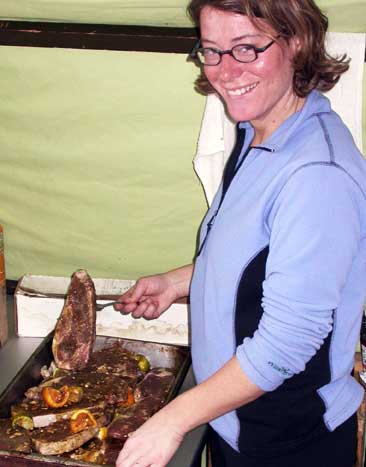
Andrea’s days are as long and hard as all of ours. She starts her days at 6:30 am, heating water for coffee. She has a small, two burner stove to cook on. The entire kitchen is similar to a simple RV kitchen. The sink is a jug of water over a five gallon bucket we call the slop bucket. Water is melted snow. Each meal takes approximately two hours to prepare. Two hours cooking times three meals, then the cleaning, water melting, shopping and planning. Andrea retires for the night after the dinner dishes are done between 9 and 10 pm. She works 7 days a week. Once we are done here Andrea will return to Mcmurdo where she will work at the Berg Field Center, helping other teams prepare for their trips into the field.
And finally, why does Andrea do her cooking for a bunch of scientists in primitive conditions for months at a time? When asked this question she replied, “It’s like having my own big family I get to cook for. And I have a lot of freedom I wouldn’t have if I cooked in some fancy restaurant, say in Chicago or something.” We’re sure glad to have Andrea, no matter how bleak the weather or arduous the work, we can count on a great meal in Andrea’s kitchen.
